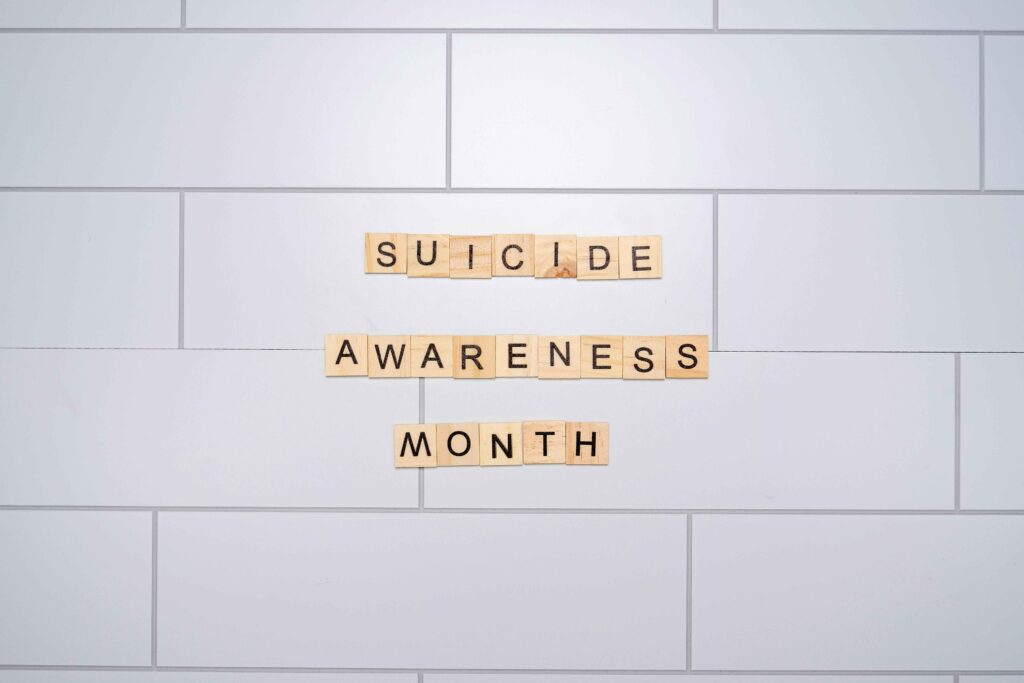1. Introduction: The Silent Mental Health Crisis and the Role of AI
Mental health has always been an integral part of human well-being, yet for decades it remained one of the least addressed aspects of public health. According to the World Health Organization (WHO), over 700,000 people die by suicide each year, making it one of the leading causes of death globally. Behind each of these numbers is a person who felt unseen, unheard, or unsupported. Traditional counseling methods, while deeply compassionate, often struggle to keep up with the growing demand for immediate mental health support.

In the digital era, where social isolation, online bullying, work pressure, and uncertainty are increasingly prevalent, the need for timely and personalized mental health assistance is greater than ever. However, human counselors cannot be available around the clock to everyone who needs help. That’s where Artificial Intelligence (AI) steps in — not as a replacement for human empathy, but as a powerful ally.
AI’s ability to analyze language, detect emotional tone, monitor behavioral patterns, and predict risk has revolutionized the field of crisis counseling. From identifying early warning signs of suicidal ideation on social media to providing immediate chat-based emotional support, AI is bridging critical gaps in mental healthcare access.
As this transformation unfolds, new career opportunities are emerging at the intersection of psychology, data science, and technology — forming a new generation of professionals trained to use AI to save lives, support individuals in distress, and promote emotional resilience across communities.
Table of Contents
2. Understanding Crisis Counseling and Suicide Prevention in the Modern Era
Crisis counseling is the process of offering immediate, short-term emotional support to individuals experiencing extreme distress. It focuses on stabilizing emotions, assessing risk, and providing coping mechanisms to prevent self-harm or suicide.
Traditionally, crisis counselors operate through helplines, hospitals, or mental health organizations, offering compassionate and non-judgmental support. However, the scale of mental health challenges in the 21st century — driven by social, economic, and digital stressors — has far outpaced the availability of trained professionals.
2.1 The Global Mental Health Gap
According to mental health reports, there is a global shortage of mental health professionals. In many low- and middle-income countries, there is less than one psychiatrist per 100,000 people. Even in developed nations, people often face long waiting lists for therapy or counseling.
AI-driven tools now act as first responders, offering instant emotional support and flagging high-risk cases to human experts for immediate intervention. This hybrid model ensures that no cry for help goes unheard — even outside regular therapy hours.
2.2 The New Ecosystem of Digital Mental Health
With the rise of chatbots, virtual therapists, AI-driven suicide prediction systems, and sentiment analysis tools, mental health support has expanded into a 24/7 digital ecosystem. AI can now:
- Detect distress patterns in voice, text, and social media posts.
- Alert human counselors in real-time for intervention.
- Suggest personalized coping strategies and wellness resources.
- Offer privacy and accessibility for those uncomfortable seeking traditional therapy.
As AI becomes deeply embedded in mental health services, it creates a demand for professionals who understand both technology and human psychology — people who can design, manage, and ethically oversee these intelligent systems.
3. How Artificial Intelligence is Transforming Crisis Response
AI has brought data-driven intelligence to one of the most emotionally complex fields — crisis counseling. While human empathy remains irreplaceable, AI can enhance it by providing real-time insights, predictive analytics, and scalable emotional monitoring.
3.1 Predicting Risk Before Crisis Happens
Machine learning algorithms trained on large datasets of text and voice data can identify subtle patterns that may indicate suicidal ideation or emotional distress. For instance:
- A sudden change in online posting behavior.
- Frequent use of self-deprecating language.
- Reduced social engagement.
Platforms like Facebook and Reddit have used AI models to flag potential suicide-related content and notify moderators or local authorities for intervention. These proactive systems can save lives before individuals reach a breaking point.
3.2 24/7 Emotional Support Through Chatbots
AI-powered chatbots such as Wysa, Woebot, and Tess provide confidential, judgment-free emotional support. Trained on psychological frameworks like Cognitive Behavioral Therapy (CBT), these chatbots help users express emotions, recognize negative thought patterns, and access mindfulness exercises instantly.
While not replacements for professional counseling, these bots act as “digital first responders,” bridging the gap between moments of emotional distress and professional help.
3.3 AI for Counselor Assistance
AI is not just user-facing — it’s also revolutionizing how human counselors work. AI-powered tools can analyze text chats or call transcripts to:
- Identify key emotional triggers.
- Highlight high-risk conversations.
- Provide suggestions or resource links in real-time.
This allows human counselors to respond more effectively and focus their emotional energy where it’s needed most.
3.4 Data-Driven Suicide Prevention Programs
Governments, NGOs, and universities are using predictive analytics to identify communities at higher risk. AI can map correlations between unemployment rates, social media sentiment, and suicide statistics — allowing mental health organizations to allocate resources more effectively.
4. AI Tools and Technologies Used in Crisis Counseling
AI technologies applied to suicide prevention and crisis counseling cover a broad spectrum — from natural language understanding to biometric analysis.
4.1 Natural Language Processing (NLP)
NLP helps AI understand human language and detect emotional cues. For example:
- Sentiment analysis detects negativity or hopelessness in messages.
- Keyword tracking identifies terms associated with suicide ideation.
- Tone analysis evaluates emotional intensity in voice or text.
4.2 Machine Learning and Predictive Analytics
Machine learning models are trained on massive datasets — including social media posts, hotline transcripts, and survey responses — to recognize risk factors and predict crises before they escalate.
4.3 Voice Emotion Recognition
Some AI systems can detect anxiety, sadness, or despair from vocal tone and breathing patterns. Voice analysis is being integrated into helpline systems to prioritize high-risk calls automatically.
4.4 Computer Vision for Behavioral Analysis
AI-powered cameras and sensors in therapeutic environments can detect physical cues like facial expressions, body movements, or restlessness — helping professionals understand non-verbal indicators of emotional distress.
4.5 Data Privacy and Ethical AI
Because of the sensitive nature of mental health data, strong emphasis is placed on ethical AI governance — ensuring user consent, data anonymization, and algorithm transparency.
5. Career Opportunities Emerging from AI-Integrated Mental Health Services
The integration of AI into mental health support has created a new generation of hybrid professions that merge psychology, technology, and ethics. These roles not only require technical know-how but also deep empathy and an understanding of mental health principles.
5.1 AI Mental Health Data Analyst
These professionals analyze emotional data collected through AI tools, helping refine predictive models and improve mental health outcomes. They interpret patterns that reveal risk factors and recommend program improvements.
5.2 Machine Learning Engineer (Mental Health Focus)
Machine learning engineers develop algorithms capable of identifying mental distress through language, voice, or behavior. They collaborate with psychologists to ensure the models align with ethical standards and clinical accuracy.
5.3 Digital Crisis Counselor
Crisis counselors now use AI dashboards that analyze chat transcripts in real time. AI provides prompts, sentiment scores, and safety flags — allowing counselors to focus on empathetic engagement rather than manual monitoring.
5.4 AI Ethics and Policy Specialist
These professionals oversee the ethical deployment of AI in sensitive fields like mental health. They ensure compliance with privacy regulations (e.g., GDPR, HIPAA) and evaluate algorithmic fairness to prevent bias.
5.5 AI Product Manager for Mental Health Startups
As mental health tech startups grow, they need managers who understand both user psychology and AI workflows. These product managers coordinate between developers, counselors, and end-users to create supportive and effective tools.

6. Required Skills and Qualifications for AI-Driven Counseling Roles
Since AI in crisis counseling is still an evolving field, the skills needed are multidisciplinary — blending human psychology with computational literacy.
6.1 Educational Background
- Psychology, Psychiatry, or Social Work for understanding human behavior.
- Computer Science, AI, or Data Science for developing and training AI systems.
- Ethics and Policy Studies for governance and compliance oversight.
6.2 Technical Skills
- Machine learning frameworks (TensorFlow, PyTorch)
- NLP libraries (spaCy, Hugging Face, NLTK)
- Data visualization and analytics (Python, Power BI, R)
- Chatbot development (Dialogflow, IBM Watson, Rasa)
6.3 Soft Skills
- Emotional intelligence and empathy.
- Crisis communication and de-escalation.
- Interdisciplinary collaboration between tech and mental health teams.
6.4 Certifications
Programs like AI for Healthcare, Data Ethics, and Digital Mental Health offered by Coursera, edX, or WHO can help professionals transition into this emerging sector.
7. Table 1: Key AI Job Roles in Crisis Counseling and Their Descriptions
| Job Title | Primary Role | Core Skills Required | Average Annual Salary (Global) |
|---|---|---|---|
| AI Mental Health Data Analyst | Analyzes emotional data and improves AI accuracy | Data analytics, psychology, NLP | $70,000–$110,000 |
| Machine Learning Engineer (Mental Health) | Builds predictive models for suicide risk detection | ML algorithms, TensorFlow, ethics | $90,000–$130,000 |
| Digital Crisis Counselor | Uses AI insights to support at-risk users in real time | Counseling, empathy, chatbot familiarity | $50,000–$85,000 |
| AI Ethics Specialist | Ensures responsible use of AI in sensitive contexts | Ethics, policy, compliance | $75,000–$120,000 |
| AI Product Manager (Mental Health) | Oversees design and rollout of AI-based therapy apps | Product management, UX, psychology | $95,000–$140,000 |
8. Ethical Challenges in AI-Driven Mental Health Support
While AI offers revolutionary potential for crisis counseling and suicide prevention, it also introduces a series of ethical, emotional, and societal dilemmas. The technology must balance its analytical power with compassion, transparency, and fairness.
8.1 The Privacy Paradox
One of the biggest challenges in AI-based mental health systems is data privacy. AI models rely on large amounts of user data — including chat logs, voice recordings, and behavioral patterns — to improve their accuracy. But this data often contains deeply personal information about individuals’ thoughts, emotions, and trauma.
Protecting this sensitive data requires:
- End-to-end encryption and secure cloud storage.
- Strict anonymization of user data before analysis.
- Transparent consent mechanisms, where users know exactly how their information will be used.
A breach in such systems could not only violate privacy but also cause severe emotional harm to users who trusted the platform during their most vulnerable moments.
8.2 The “Empathy Gap” in AI
AI tools, no matter how sophisticated, lack genuine empathy. They can recognize emotional cues and simulate compassion, but they do not feel. This raises questions about:
- Can a chatbot truly comfort a suicidal person?
- What happens if an AI misinterprets distress as casual conversation?
Therefore, AI must always function as an assistant, not a replacement, for human counselors. The best models are hybrid systems where AI detects, analyzes, and prioritizes — but the final emotional
intervention is always handled by trained professionals.
8.3 Bias and Fairness Issues
Algorithmic bias can be especially dangerous in mental health contexts. If the dataset used to train an AI model is unbalanced — for example, overrepresenting one culture or language — it might misinterpret distress signals from other groups.
This could lead to:
- Under-detection of suicidal intent among certain demographics.
- Misdiagnosis or inappropriate recommendations.
- Cultural insensitivity in automated responses.
To counter this, organizations must employ bias auditors, diverse data sources, and ethics review boards during model training.
8.4 Accountability and Transparency
When an AI system fails to flag a high-risk user or gives an incorrect response, who is responsible — the developer, the psychologist, or the organization? Establishing accountability in such life-sensitive fields requires clear ethical frameworks and explainable AI (XAI) models that show why a certain decision was made.
8.5 Emotional Fatigue for Human Moderators
AI may help automate crisis detection, but human counselors still have to intervene. Exposure to continuous high-risk cases can cause secondary trauma or burnout among crisis workers. Future careers in this field will include roles dedicated to AI-assisted counselor well-being, where technology helps manage emotional load and recommend rest or support resources.
9. Real-World Case Studies: AI in Action for Crisis Prevention
AI in crisis counseling isn’t theoretical — it’s already saving lives across the world. Here are some notable examples and their career implications.
9.1 Facebook’s Suicide Prevention AI
Facebook has integrated AI to scan live videos and posts for signs of suicidal ideation. Using pattern recognition and natural language processing, the system flags potentially concerning content and alerts local emergency responders or support services.
Career opportunities from this include:
- AI Safety Specialists ensuring model accuracy.
- Ethical Review Officers monitoring bias and privacy.
- Partnership Managers connecting tech firms with local NGOs.
9.2 Crisis Text Line and Machine Learning
The Crisis Text Line, a U.S.-based organization, uses AI to analyze millions of text messages exchanged between counselors and people in distress. The AI prioritizes users who are at the highest risk based on specific keywords and sentence patterns, ensuring immediate human response.
Roles created by such systems include:
- AI Operations Analysts, who monitor real-time chatbot performance.
- Data Scientists, improving model sensitivity to context.
- Crisis AI Trainers, who help AI systems “learn empathy” through linguistic datasets.
9.3 Wysa: An AI Mental Health Companion
Wysa, developed by Touchkin Global, is an AI-driven emotional well-being app that uses CBT and mindfulness to assist users with anxiety, depression, and loneliness. It offers a safe, anonymous space for people to talk about their feelings.
Career roles include:
- AI Behavior Designers, crafting psychologically supportive dialogues.
- Clinical Data Annotators, labeling emotional data for model training.
- AI Product Managers, aligning technological goals with ethical care standards.
9.4 MIT’s AI Suicide Prediction Model
Researchers at MIT Media Lab developed algorithms that analyze linguistic and behavioral patterns to detect suicidal ideation with high accuracy. These models are used in digital therapy platforms and telehealth services to identify users needing urgent support.
Career areas emerging here include:
- AI Research Scientists (Mental Health Focus).
- Ethical AI Consultants for healthcare systems.
- AI Integration Specialists linking predictive systems with clinical software.
9.5 Mindstrong Health and Data-Driven Psychiatry
Mindstrong Health, a mental health startup, uses smartphone activity data — typing speed, scrolling patterns, interaction frequency — to assess mental well-being. Its AI models can detect cognitive changes associated with depression or relapse risk.
Career paths here include:
- Digital Phenotyping Researchers, exploring behavioral biomarkers.
- AI Psychometrics Engineers, refining models to interpret emotion-related data accurately.
10. Global Companies and Startups Driving AI in Suicide Prevention
| Organization / Startup | Core AI Application | Headquarters | Key Career Opportunities |
|---|---|---|---|
| Crisis Text Line | NLP-based prioritization for text counseling | USA | Data Scientist, AI Trainer, Mental Health Analyst |
| Wysa | CBT-based AI chatbot for emotional wellness | India/UK | Product Manager, Behavior Designer, Data Annotator |
| Mindstrong Health | Smartphone-based mental health analytics | USA | Research Scientist, AI Engineer, Psychometrics Expert |
| TalkLife | Peer-to-peer emotional support enhanced by AI monitoring | UK | AI Operations Manager, Ethics Specialist |
| Woebot Health | AI-driven conversational agent for therapy | USA | Machine Learning Engineer, Clinical NLP Specialist |
| Kintsugi | Voice biomarkers to detect emotional distress | USA | Voice AI Researcher, Audio Data Engineer, UX Analyst |
11. The Interdisciplinary Nature of AI Mental Health Careers
One of the most exciting aspects of this field is that it thrives at the intersection of diverse disciplines. A professional in this space could come from:
- Psychology and Psychiatry — bringing expertise in mental health and therapy.
- Computer Science and Data Science — building AI systems and analyzing data.
- Ethics, Sociology, or Law — ensuring compliance and protecting human rights.
- Public Health and Education — integrating AI-based prevention in institutions.
This interdisciplinary collaboration ensures that AI systems for mental health are technically sound, emotionally intelligent, and socially responsible.

12. How to Start a Career in AI for Crisis Counseling and Suicide Prevention
12.1 Step 1: Build a Strong Foundation
Start with a degree in:
- Psychology or Neuroscience, to understand mental processes.
- Computer Science or Artificial Intelligence, to learn algorithmic design.
- Public Health or Social Work, for community-based awareness.
Dual knowledge in psychology and data analysis provides the strongest advantage.
12.2 Step 2: Learn Relevant Tools and Technologies
Familiarize yourself with:
- NLP Tools: SpaCy, Hugging Face Transformers, NLTK.
- Machine Learning Libraries: TensorFlow, PyTorch, Scikit-learn.
- Voice Analytics Platforms: OpenSMILE, Kintsugi APIs.
- Chatbot Frameworks: Rasa, IBM Watson Assistant, Google Dialogflow.
12.3 Step 3: Understand AI Ethics and Data Governance
Enroll in certifications like:
- “Ethics of AI and Big Data” (edX).
- “AI for Mental Health” (Coursera).
- “Responsible AI Design” (Udemy).
Understanding how to design AI responsibly is crucial when dealing with vulnerable users.
12.4 Step 4: Gain Practical Experience
- Volunteer for digital helplines and online mental health NGOs.
- Work on open-source AI mental health datasets.
- Contribute to ethical AI policy discussions in professional forums.
12.5 Step 5: Join an Organization or Startup
Mental health technology is one of the fastest-growing areas in digital healthcare. Look for startups or nonprofits where your combined psychology-tech expertise can make an immediate impact.
13. The Role of Governments and Institutions
AI-driven crisis intervention requires cross-sector cooperation. Governments, tech firms, NGOs, and universities are partnering to ensure AI is used ethically and effectively.
- Public Health Agencies use AI to identify suicide clusters or mental health trends.
- Universities integrate AI courses into psychology and social work programs.
- Tech Companies collaborate with therapists to refine chatbots for compassion.
- NGOs rely on AI tools to manage high volumes of help requests efficiently.
These collaborations are creating stable, well-funded job markets for skilled professionals passionate about mental wellness.
14. The Future of AI in Suicide Prevention
14.1 Integration with Wearables
Future systems will integrate AI with wearables to monitor stress, heart rate, and sleep — identifying potential breakdowns before they happen.
14.2 Multilingual AI Counselors
Most mental health AI tools are still English-based. Expanding to regional languages, including Hindi, Spanish, and Arabic, will create opportunities for AI Linguists and Localization Specialists.
14.3 Emotionally Adaptive AI
Next-generation systems will use reinforcement learning to adapt communication styles to users’ moods and personalities, creating more natural and empathetic interactions.
14.4 AI-Powered Community Interventions
AI can map emotional health at the community level, identifying high-risk zones during natural disasters, pandemics, or economic crises — helping governments deploy mental health teams proactively.
14.5 Mental Health Metaverse
Emerging startups are exploring virtual therapy environments using AI avatars, where individuals can safely express emotions in immersive settings. Careers will emerge in AI Avatar Design and VR Mental Health Facilitation.
15. Table 2: Future Career Roles Emerging in AI-Based Mental Health Support
| Future Role | Description | Required Skills | Career Outlook (Next 5 Years) |
|---|---|---|---|
| AI Empathy Designer | Develops emotionally intelligent chat and voice models | NLP, Psychology, UX Design | High |
| Digital Mental Health Auditor | Evaluates ethics, bias, and fairness of AI systems | Data Governance, Ethics | High |
| Mental Health Data Curator | Organizes secure datasets for AI training | Data Management, Privacy Law | High |
| Virtual Reality Therapist | Combines VR and AI for immersive emotional therapy | VR Design, CBT, AI Interaction | Growing |
| Community AI Analyst | Uses AI data to guide mental health policy | Data Analytics, Public Health | High |
16. Long-Term Impact of AI on Human Counselors
Rather than replacing therapists, AI is augmenting human empathy. Counselors supported by AI can:
- Spend more time providing genuine emotional care.
- Access real-time risk assessments.
- Receive burnout alerts and wellness suggestions from AI assistants.
This partnership creates a symbiotic model — technology for efficiency, humans for empathy.
17. Challenges Ahead
Despite progress, several challenges must be addressed:
- Cultural barriers: Some societies still view AI mental health tools with skepticism.
- Accessibility: Limited internet access in rural areas restricts reach.
- Regulatory uncertainty: Clear global standards for AI in healthcare are still evolving.
Solving these challenges requires policy innovation, cross-border cooperation, and continuous ethical oversight.
18. How Professionals Can Stay Ahead
To remain competitive in this growing sector:
- Keep learning — enroll in online AI psychology programs.
- Network — join AI mental health communities on LinkedIn or Reddit.
- Contribute — publish research or case studies on ethical AI use.
- Collaborate — build bridges between developers and psychologists.
- Advocate — promote responsible AI adoption through policy forums.
19. The Human Element: Why Empathy Still Matters
AI can detect risk, but only humans can provide meaningful connection.
Every crisis is deeply personal — what one person expresses as sadness might be another’s cry for help. AI’s ability to recognize patterns must always be guided by human intuition, kindness, and ethical judgment.
In this sense, AI is not the hero — it’s the partner helping humans reach others faster, with more context and precision.
21. AI’s Role in Cultural and Regional Mental Health Adaptation
AI-driven crisis counseling systems must understand not only emotions but also culture, language, and context. Mental health expression differs vastly between regions — and this cultural nuance is where AI is now making rapid progress.
21.1 Understanding Cultural Expression of Emotion
In many Asian or African cultures, people may not openly use terms like “depression” or “anxiety.” Instead, they express distress through physical symptoms — fatigue, headaches, or loss of appetite. AI models that are trained only on Western data often fail to interpret these cues correctly.
To address this, researchers are developing localized language models that can:
- Recognize metaphors, idioms, and slang that express emotional pain.
- Analyze non-verbal cues from voice tone or writing rhythm.
- Adjust responses based on cultural communication norms.
For example, an AI counselor trained in India might understand phrases like “I’m feeling too heavy in my heart” as sadness, while a Western model might misinterpret it literally.
21.2 The Rise of Multilingual and Regional AI Counselors
AI mental health startups are rapidly expanding into regional and vernacular languages.
Tools like Wysa (India) and Talia (Africa) now offer AI-driven chat in multiple local languages, enabling people to seek support anonymously and comfortably.
This opens massive job opportunities for:
- AI Linguists — training mental health bots in dialects and emotion-based semantics.
- Localization Psychologists — adapting counseling frameworks to regional cultures.
- AI Translators — ensuring accurate translation of emotional context across languages.
21.3 The Importance of Regional Ethics Boards
Each country has different laws about data privacy and emotional well-being.
For example:
- The EU’s GDPR demands explicit consent before storing emotional data.
- In India, Digital Personal Data Protection (DPDP) Act regulates sensitive AI health data.
- The U.S. HIPAA Act governs medical AI used for patient data handling.
Hence, AI mental health systems must adapt legally to each region. This has created a rising demand for AI Ethics Compliance Officers specializing in mental health tech law.
These professionals ensure:
- Legal compliance with regional data laws.
- Secure storage of counseling data.
- Transparency in how emotional data is processed and used.

22. The Psychology Behind AI Empathy and Human Trust
While AI cannot truly feel empathy, it can learn to mimic empathetic communication patterns. Understanding how humans form emotional trust is vital for designing successful AI counselors.
22.1 The Science of Empathy Simulation
Psychologists classify empathy in two forms:
- Cognitive empathy — understanding what someone feels.
- Affective empathy — actually feeling the emotion yourself.
AI systems can achieve cognitive empathy using natural language processing and emotional analytics. For example:
- Detecting sadness or anger through sentiment analysis.
- Adjusting tone or suggestions to match emotional state.
However, affective empathy remains uniquely human — and that’s why AI-human collaboration is the gold standard.
22.2 Building Human Trust in AI Counselors
Trust is earned through predictability, transparency, and respect. Users must know what the AI can and cannot do.
For instance:
- AI chatbots should disclose they are not human at the beginning.
- All data usage must be clearly explained.
- Users should always have access to human escalation — a real counselor for sensitive cases.
By maintaining this transparency, AI tools become extensions of trust, not replacements for it.
22.3 Emotional Intelligence in Design
AI empathy design is now a standalone career. “Emotion-Centric AI Designers” are tasked with ensuring digital interfaces communicate warmth and care.
They integrate psychological frameworks like:
- Cognitive Behavioral Therapy (CBT)
- Dialectical Behavior Therapy (DBT)
- Compassion-Focused Therapy (CFT)
By encoding therapeutic language patterns into AI chat systems, these professionals help users feel seen and understood even during digital interactions.
22.4 The Challenge of Over-Reliance
There’s a thin line between helpful and harmful AI empathy. Over-reliance can make users emotionally dependent on bots rather than seeking real social support.
Hence, developers and psychologists must collaborate to:
- Encourage human connection through AI recommendations.
- Avoid addictive or manipulative emotional feedback loops.
- Maintain human review mechanisms for at-risk users.
This is creating new jobs like AI Emotional Risk Auditors, ensuring the systems remain ethical and non-addictive.
23. The Global Future of AI Mental Health Careers (Predictions 2030–2040)
As mental health becomes a global policy priority, the integration of AI is not only inevitable but necessary. The next two decades will redefine how emotional health is understood, monitored, and supported.
23.1 Global Expansion of AI Mental Health Services
By 2030, AI-powered emotional well-being platforms are expected to reach over 2 billion people, according to WHO projections.
AI will assist in:
- Suicide risk mapping at community levels.
- Predictive analysis of public stress during pandemics or economic recessions.
- 24/7 multilingual support networks run jointly by NGOs and governments.
This will create tens of thousands of new jobs, particularly in developing countries where mental health infrastructure is limited.
23.2 Career Growth Projections
According to emerging digital health trends, AI-driven counseling roles will experience a 65–80% growth rate over the next decade. Some of the most in-demand roles will include:
- AI Mental Health Data Analysts
- AI Behavior Trainers
- Clinical AI Product Managers
- AI Voice Emotion Specialists
- Neuroinformatics Experts
- AI Policy and Governance Leads
In India alone, demand for AI-based behavioral data scientists is projected to rise by 70% between 2026 and 2032, as companies like Tata Digital, Wysa, and Practo scale their emotional wellness solutions.
23.3 The Integration of Brain-Computer Interfaces (BCI)
By the late 2030s, AI will integrate with neural signal analysis to detect emotional states directly through brainwave monitoring.
This emerging subfield — Neuro-AI for Emotional Health — will open up career paths such as:
- Neuro-AI Data Engineer
- Cognitive AI Researcher
- Mental State Signal Analyst
These professionals will help build next-gen AI systems that detect depression or anxiety early through brainwave data — ethically, safely, and compassionately.
23.4 AI in Schools and Universities
Educational institutions will soon deploy AI-powered counseling assistants that identify students showing emotional distress through digital footprints (grades, attendance, social media behavior).
Career opportunities will include:
- AI Academic Counselors — integrating AI alerts into school guidance systems.
- Digital Education Psychologists — combining pedagogy and AI analytics.
- Student Mental Health Data Officers — ensuring ethical use of student data.
23.5 Global Public Health Integration
Countries will collaborate through global frameworks like:
- WHO’s AI Mental Health Standards (proposed 2030).
- OECD AI Ethics Charter for Emotional Technology.
- UN Digital Health for Humanity Program.
Professionals skilled in AI ethics, public health, and psychology will be essential to implement and monitor these international programs.
24. Societal Benefits of AI Mental Health Revolution
AI in suicide prevention and counseling isn’t just a technological upgrade — it’s a social transformation. The ripple effects extend across entire communities.
24.1 Reducing Stigma
AI-based tools allow users to seek help privately and anonymously, reducing the stigma associated with mental illness. When people realize they can talk to a digital counselor without judgment, they’re more likely to reach out before it’s too late.
24.2 Empowering Non-Urban Populations
In countries where professional counselors are scarce, AI chatbots can serve as first responders. They provide comfort, guidance, and early detection — while connecting users to local helplines for deeper care.
This creates demand for AI Support Coordinators — professionals who bridge between digital help and real-world response networks.
24.3 Data-Driven Policy Decisions
With millions of anonymized conversations analyzed daily, governments can identify mental health patterns at scale. AI helps determine:
- Regions with rising stress or suicide rates.
- Socio-economic triggers for mental health decline.
- Community-specific intervention strategies.
These insights fuel evidence-based policymaking, leading to smarter allocation of public health resources.
25. The Human-AI Partnership: Redefining Compassion in Technology
AI’s success in suicide prevention is not because it replaces humans — but because it enhances human compassion with speed, scale, and precision.
25.1 Symbiotic Collaboration
AI analyzes; humans empathize.
Together, they form a dual-layer safety net:
- The machine catches subtle warning signs.
- The counselor delivers real emotional connection.
This partnership makes interventions faster, deeper, and more humane.

25.2 Emotional Resilience for Counselors
AI can also monitor the emotional well-being of human counselors themselves. It detects fatigue or stress based on voice tone, typing rhythm, or response times — suggesting rest breaks or mental health check-ins.
Thus, AI doesn’t only help patients — it protects the protectors.
25.3 Expanding the Definition of Empathy
AI will redefine empathy beyond human limitations. Instead of emotional imitation, the future of AI empathy will be contextual accuracy — knowing exactly what to say at the right time to prevent harm.
25.4 The Moral Responsibility
As these systems evolve, professionals in the field must uphold a single ethical truth:
“AI should amplify humanity, not replace it.”
Every algorithm developed for mental health must be built with respect, inclusivity, and care at its core.
26. Conclusion: The Future Belongs to Human-AI Collaboration in Mental Health
As mental health challenges continue to rise globally, AI offers the hope of scalable, personalized, and timely intervention. Yet, the most powerful systems will always be human-centered, ensuring that compassion drives every algorithm.
A decade from now, professionals in this field — whether data scientists, psychologists, or AI ethicists — will play one of the most meaningful roles of our time: saving lives through technology.
Building a career in AI-driven crisis counseling isn’t just about innovation — it’s about restoring humanity through digital compassion. By merging empathy with engineering, today’s generation can build tools that prevent tragedy, heal emotional wounds, and make the world safer for everyone.
follow us on whatsapp channel

















